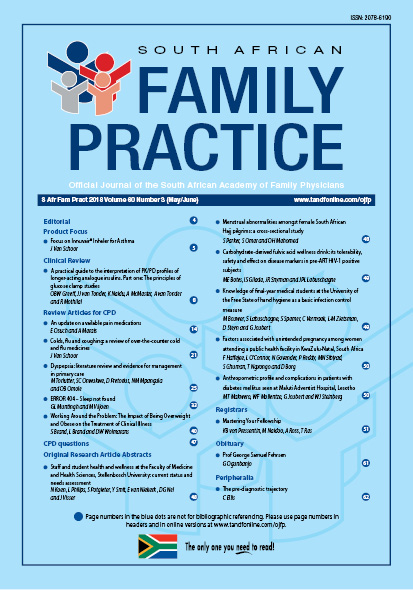Anthropometric profile and complications in patients with diabetes mellitus seen at Maluti Adventist Hospital, Lesotho
Keywords:
anthropometric profile, complications, diabetes mellitus, eye examination, Lesotho, physical examination
Abstract
Background: Patients attending outpatient departments for follow-up of diabetes mellitus (DM) may seem content about the control of their disease. However, complications resulting from DM may present before diagnosis and treatment initiation or continue to develop while on treatment. Aim: This study aimed to report on the prevalence of DM complications in patients with DM at Maluti Adventist Hospital, Lesotho. Methods: A cross-sectional study was conducted in 150 DM patients recruited from Maluti Adventist Hospital’s newly formed clinic between May and June 2009. Demographic information was obtained through a structured interview. Patients underwent physical and eye examinations to obtain an anthropometric profile and identify DM complications. Laboratory and ECG investigations were done to establish level of glycaemic control and identify other complications. Results: Patients were female (80.7%) with a mean age of 58.2 years (standard deviation 13.2). Almost all patients had type 2 DM (94.7%) and 60.1% had been diagnosed during the preceding five years. The most common co-morbidity was hypertension (85.3%) and 49.7% of patients were obese (mean body mass index 30.4 kg/m2). Patients had poor short-term (46.2%) and longterm (57.5%) glycaemic control. Nearly half (43.3%) of the patients had evidence of peripheral neuropathy. Almost 60% of the patients had a blood pressure of > 130/80 mmHg. Of the 128 patients seen by the ophthalmologist, 29.9% had evidence of cataracts in both eyes. Funduscopic abnormalities were found in 32.8% of the patients. Patients with complications or poor glycaemic control had been diagnosed for a significantly longer time. Conclusion: Patients showed evidence of DM complications at the time of study. Coupled with significant co-morbidities and high body mass index, the risk of morbidity and mortality is high. A comprehensive approach is needed in managing these patients, if meaningful reductions in morbidity and mortality are to be achieved. (Full text of the research articles are available online at www.medpharm.tandfonline.com/ojfp) S Afr Fam Pract 2018; DOI: 10.1080/20786190.2018.1426901
Section
Research Articles
By submitting manuscripts to SAFP, authors of original articles are assigning copyright to the South African Academy of Family Physicians. Copyright of review articles are assigned to the Publisher, Medpharm Publications (Pty) Ltd, unless otherwise specified. Authors may use their own work after publication without written permission, provided they acknowledge the original source. Individuals and academic institutions may freely copy and distribute articles published in SAFP for educational and research purposes without obtaining permission.

